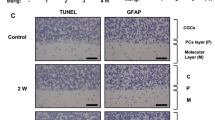Abstract
The present study was undertaken to establish mode of action, comparative therapeutic efficacy and safety evaluation of N-acetyl cysteine and dithiothreitol against acute dimethylmercury poisoning in rats. Male Sprague–Dawley albino rats (150 ± 10 g) were randomly divided into six groups. Group 1 served as control. Group 2–4 were administered dimethylmercury (10 mg/kg, p.o.) once only and group 2 served as experimental control. Animals of group 3 and 4 were received N-acetyl cysteine and dithiothreitol. Compared to the control, significant increase (p ≤ 0.05) was observed in the activities of aspartate aminotransferase, alanine aminotransferase, alkaline phosphatase, lipid peroxidation level and mercury ion concentration, however reduced glutathione, catalase, adenosine triphosphatase, acetyl cholinesterase (in brain only) were also decreased. It was concluded that N-acetyl cysteine provided maximum protection when compared with dithiothreitol group.
Similar content being viewed by others
References
Agrawal R, Wankade K (2003) Mercury levels rising dangerously Toxics Link
Aremu DA, Madejczyk MS, Ballatori N (2008) N-acetyl cysteine as a potential antidote and biomonitoring agent of methylmercury exposure. Environ Health Perspect 116:26–31
Barnes JL, McDowell EM, McNeil JS, Flamenbaum W, Trump BF (1980) Studies on the pathophysiology of acute renal failure. IV. Protective effect of dithiothreitol following administration of mercuric chloride in the rat. Virchows Arch B Cell Pathol Incl Mol Pathol 32:201–232
Brehe JE, Burch HB (1976) Enzymatic assay for glutathione. Anal Biochem 74:189–197
Ellman GL, Courtney KD, Andres V, Feather-Stone RM (1961) A new and rapid colorimetric determination of acetylcholinesterase activity. Biochem Pharmacol 7:88–95
Giradi E, Elias M (1993) Effect of different glutathione levels on renal mercury deposition and excretion in the rat. Toxicology 81:57–67
Hawk PB, Oser BL, Summerson WH (1954) Practical physiological chemistry, 13th edn. McGraw Hill, New York
Hultberg B, Andersson A, Isaksson A (2001) Interaction of metals and thiols in cell damage and glutathione distribution: potentiation of mercury toxicity by dithiothreitol. Toxicology 156:93–100
Jacobs MB, Goldwater YamaguchiS, LJ GilbertH (1960) Determination of mercury in blood. Am Ind Hyg Assoc J 21:475–480 PMID- 13718571
Ketterer B, Coles B, Meyer DJ (1983) The role of glutathione in detoxification. Envir Health Perpec 49:59–69
Pal S, Chatterjee A (2004) Protective effect of N-acetyl cysteine against arsenic induced depletion in vivo of carbohydrate. Drug Chem Toxicol 27:179–189
Ramanathan K, Shila S, Kumaran S, Panneerselvam C (2003) Ascorbic acid and alpha-tocopherol as potent modulators of arsenic-induced toxicity in mitochondria. J Nutr Biochem 14:416–420
Reitman S, Frankel SA (1957) A colorimetric method for the determination of serum glutamic oxaloacetic and glutamic pyruvic transaminases. Am J Clin Pathol 28:56–63
RTECS (Registry of Toxic Effects of Chemical Substances) (1985–1986) US Dept of Health and Human Services. Wahington
Seth PK, Tangri KK (1966) Biochemical effects of newer salicylic acid congenesis. J Pharma Pharmacol 18:831–833
Sharma SK, Krishna Murti CR (1968) Production of lipid peroxidation by brain. J Neurochem 15:147–149
Sharma MK, Sharma A, Kumar A, Kumar M (2007) Spirulina fusiformis provides protection against mercuric chloride induced oxidative stress in Swiss albino mice. Food Chem Toxicol 45:2412–2419
Singh V, Joshi D, Shrivastava S, Shukla S (2007) Effect of monothiol along with antioxidant against mercury-induced oxidative stress in rat. Indian J Exp Biol 45:1037–1044
Sinha AK (1972) Colorimetric assay of catalase. Anal Biochem 47:389–394
Snedecor GW, Cochran WG (1994) Statistical analysis, 8th edn. Lowa State University Press, Ames
US EPA (2000) Mercury research strategy. US Environmental Protection Agency, Washington
Acknowledgments
Deepmala Joshi is grateful to the Jiwaji University, Gwalior- (M.P.) for Scholarship (F/DEV/2007/1277) 2004-2006. Authors want to thank to Prof. R. Mathur, School of Studies in Zoology, Jiwaji University, Gwalior for their invaluable suggestions.
Author information
Authors and Affiliations
Corresponding author
Rights and permissions
About this article
Cite this article
Joshi, D., Mittal, D.K., Shrivastava, S. et al. Protective Role of Thiol Chelators Against Dimethylmercury Induced Toxicity in Male Rats. Bull Environ Contam Toxicol 84, 613–617 (2010). https://doi.org/10.1007/s00128-010-9982-3
Received:
Accepted:
Published:
Issue Date:
DOI: https://doi.org/10.1007/s00128-010-9982-3




